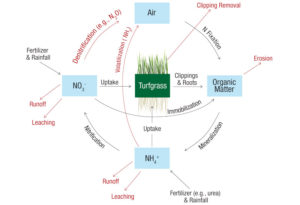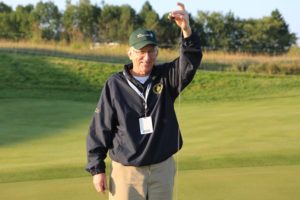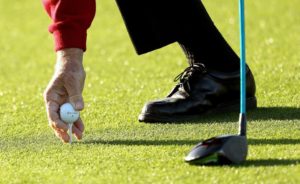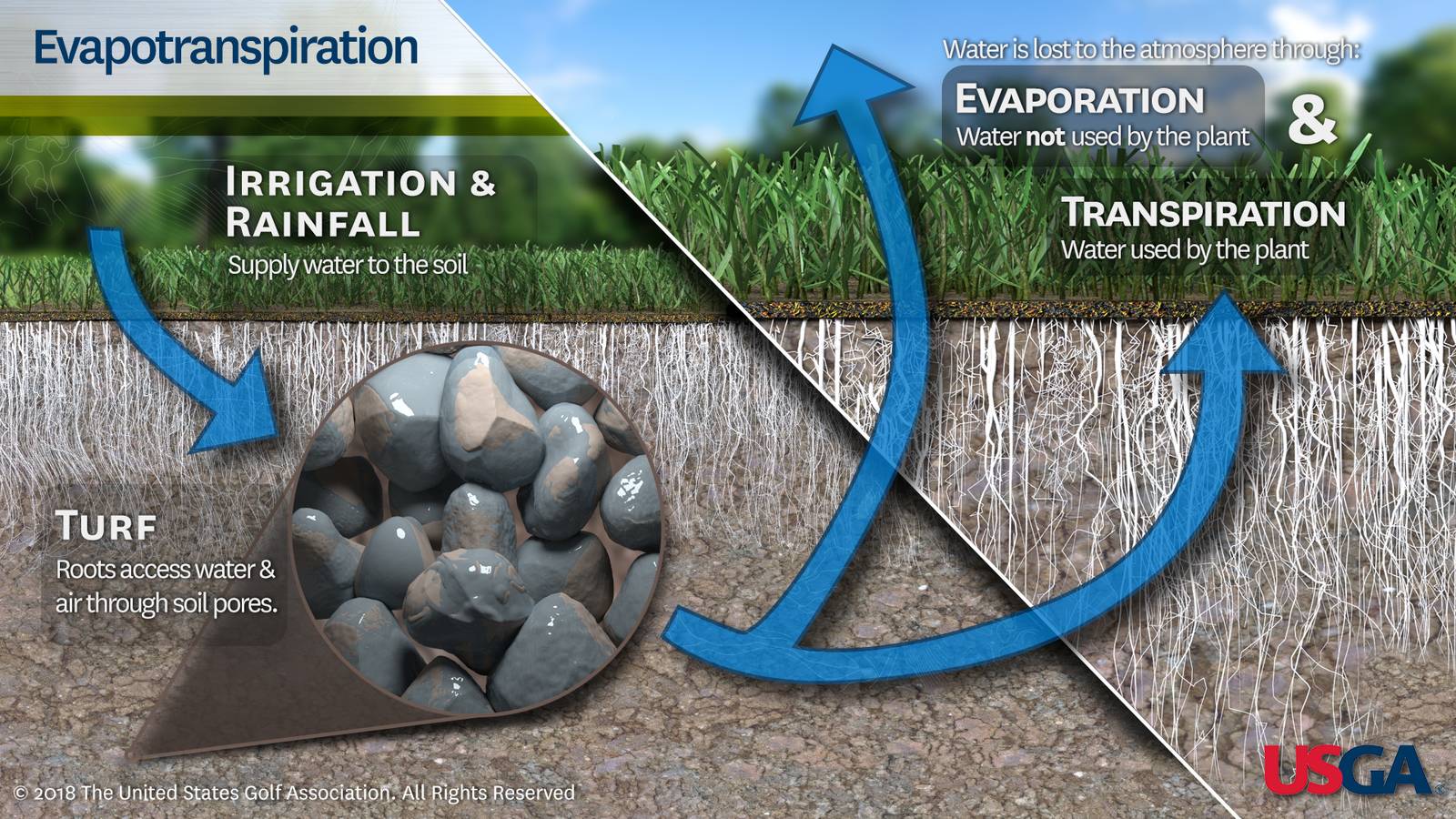50 State Coronavirus Update
Information, by state, of restrictions and closures in response to the COVID-19 pandemic. A a downloadable PDF version is also available.
This article is originally posted and taken from GCSAA.
Information, by state, of restrictions and closures in response to the COVID-19 pandemic. A a downloadable PDF version is also available.
This article is originally posted and taken from GCSAA.
Michigan lawns are commonly a mix of Kentucky bluegrass, creeping red fescue and perennial ryegrass. Sodded turf is usually a blend of varieties of Kentucky bluegrass. These grasses are cool-season grasses — they grow best in spring and also in late summer to early fall when days are warm and nights are cool. Spring and fall are times of growth for blades and roots of grass plants and the development of new plants. Simple cultural practices through the summer can aid the grass in surviving the stresses of summer.
Cool-season turfgrasses often require supplemental watering in the summer to remain green and actively growing. During hot and dry periods, the turf needs light, frequent waterings that add up to 1/2 inch to 1 1/2 inches of water per week. Grass roots are naturally shorter during hot, dry conditions of summer, and applying too much water at that time can waste water because it simply moves past the root zone of the plants. The best time of the day for watering is morning to early afternoon. Avoid watering in the evening — this extends the time that lawns remain wet through the night, and that can encourage fungus diseases. If summer watering restrictions are in place that ban daytime watering, then apply water to turf between midnight and daybreak.
Click here to view full article.
This article is originally posted and taken from Michigan State University.
Last week a possible case of annual bluegrass weevil was reported at a course in central Wisconsin and was confirmed as ABW last night by both UW Insect Diagnostic Lab Manager P.J. Liesch and Penn State Entomologist Dr. Ben McGraw. ABW is a serious pest of annual bluegrass that has primarily only been found in the eastern portion of the country…the closest confirmed case of ABW to Wisconsin prior to this was in Cleveland, OH. We believe ABW came in on sod that was purchased from the eastern part of the country several years ago.
While this is a significant development, there is also no need to panic. ABW spreads very slowly and is unlikely to be on many of your courses now or in the near future, but it’s still important to be aware of a new and damaging pest in the area.
I have created a webpage with answers to a few basic questions, links to additional resources, and contact information for UW Insect Diagnostic Lab Manager and PSU Professor (and ABW expert) Ben McGraw.
The website address is here: https://tdl.wisc.edu/2020/07/01/new-pest-alert-annual-bluegrass-weevil-in-wisconsin/
Even though I’m a pathologist, please don’t hesitate to contact me with any questions you might have.
Paul Koch, Ph.D.
Assistant Professor
Department of Plant Pathology
Molecular and Environmental Toxicology Center
University of Wisconsin – Madison
608-262-6531
This article is originally posted and taken from MiGCSA.

Figure 1. Simplified conceptual model illustrating the nitrogen cycle. Illustration by Ross Braun
Editor’s note: This research was funded in part by the United States Golf Association.
The goal of a nitrogen fertilizer program should be to optimize plant uptake while minimizing nitrogen losses, such as runoff, leaching and gaseous losses. As stewards of the environment, golf course superintendents should understand how nitrogen moves in the environment and be aware of the importance of preventing nitrogen fertilizer from contaminating groundwaters and surface waters through leaching and runoff. They should also be aware of reducing gaseous losses of nitrogen.
No single nitrogen fertilizer program is best for all turf. Nitrogen fertilizer programs will vary by turf species, especially between cool- and warm-season grasses, and among soil conditions (for example, soil type, properties, pH, slope, soil water content and soil temperature) and site conditions (for example, environment, climate and site use). Therefore, an effective nitrogen fertilizer program incorporates information about the soil and site conditions, the appropriate nitrogen amounts and timing of application, and what happens to the nitrogen fertilizer once it is applied to the turf.
Plants absorb nitrogen as both nitrate (NO3–) and ammonium (NH4+), and preference for either varies by age and type of plant, environment, and other factors. In the turf industry, most of the nitrogen fertilizer is applied as urea, which is quickly converted to ammonium by urease, an enzyme found in soils and on the turf.
Does all the nitrogen fertilizer applied get taken up by the plant? No. Why not? Because at the time of fertilizer application, multiple environmental factors and management practices may influence the nitrogen processes on the turf and in the soil, and these practices may result in the loss of nitrogen through multiple nitrogen pathways in the soil-plant-atmosphere system (Figure 1, above).
One of these nitrogen pathways is denitrification, the process by which denitrifying bacteria convert nitrate into dinitrogen (N2), nitric oxide (NO) and nitrous oxide (N2O) gases, which are all released into the atmosphere.
Nitrous oxide, an important greenhouse gas associated with global climate change, is reportedly 310 times more effective than carbon dioxide (CO2) at trapping longwave radiation (that is, heat) in the atmosphere, and it is, potentially, the gas that is responsible for the greatest depletion of ozone (6, 10).
From 1990 to 2005, agricultural activities (nitrogen fertilization and soil management) have increased worldwide nitrous oxide emissions by 17% (6, 12). Applications of fertilizer to agricultural land — including turfgrass systems (4, 7, 8) — are responsible for a significant percentage of the nitrous oxide emitted into the atmosphere each year (9).
Denitrification typically occurs under anaerobic conditions — wet soil conditions with an absence or limited amount of free oxygen. Therefore, an increase in soil moisture during or after nitrogen fertilization may significantly amplify nitrous oxide fluxes.
Past research in turfgrass has shown nitrous oxide emissions typically increase after nitrogen fertilization (especially with quick-release fertilizers) that is followed by precipitation or irrigation (1, 4, 7, 8). Turfgrass researchers measuring nitrous oxide emissions have concentrated mainly on quick-release fertilizers, and few investigations have looked at the influence of controlled-release (slow-release) fertilizers on nitrous oxide emissions.
The use of controlled-release fertilizers, such as polymer-coated urea (PCU) or sulfur-coated urea (SCU), may reduce emissions by decreasing the amount of nitrogen in the soil that is available for denitrification (11). Therefore, in order to develop management practices that have the potential to reduce nitrous oxide emissions in turfgrass, further research is required on the effects of the amount of irrigation and the different forms of nitrogen fertilizer on nitrous oxide emissions (2).
We hypothesized that employing smarter turfgrass management practices such as combining the use of controlled-release fertilizers with improved irrigation techniques (for example, deficit irrigation) would reduce N2O emissions.

In the early days of firmness testing, a steel ball was dropped from about head height onto a putting surface, and the depth of the resulting indentation was measured. Photos courtesy of Luke Cella
Editor’s note: This article was originally published in the October 2018 issue of On Course, the monthly publication of the Midwest Association of Golf Course Superintendents.
We live in a data-driven world, and the decisions you make on the golf course are not immune to this influence. How do you sift through all the data produced and collected every day from your golf course and use it to make sound decisions?
I recently took part in a meeting where superintendents were discussing their decision-making process when it comes to applying plant protectants. This made me think of some of the tools available to superintendents that enable them to collect data. Whether it be chemical use, green speeds or labor expenses, superintendents are constantly putting numbers to their efforts.
In 1969, a method to estimate heat accumulation by determining daily maximum and minimum temperatures using a sine curve to approximate the diurnal temperature curve was first published. It underwent several iterations, and in 1983, the concept took hold. Researchers Lloyd Wilson and William Barnett of the University of California stated in the opening paragraph of their 1983 research article on degree days, “Questions such as when to plant, whether the crop is developing on time, and when to initiate set control actions are particularly difficult to answer, because the timing it not always the same each year.”
Most superintendents are astutely aware of growing degree days and use them for scheduling applications of plant protectants (including growth regulators for seedhead suppression), some early-spring fungicides and certain insecticides. There are numerous growing degree day calculators out there, and no matter which calculator or model one uses, all of them state in one form or another, “When it comes to growing degree day models, it is important to remember that although they serve as useful guides, they don’t replace scouting techniques or your own observations” (GreenCast, Syngenta).
This article is originally posted and taken from GCM.
Mike Goatley, Shawn Askew, and David McCall, School of Plant and Environmental Sciences, Blacksburg
Jeff Derr and Adam Nichols, School of Plant and Environmental Sciences, VT Hampton Roads Agriculture Research and Extension Center, Va Beach
Jordan Booth, Research Associate, School of Plant and Environmental Sciences, Midlothian
What problems will turfgrasses face due to the impacts of a natural disaster such as a hurricane or tropical storm? The prospect of hurricanes either directly or indirectly impacting Virginia escalate in the fall and far too often our Tidewater residents in particular have to prepare (and deal) with the fiercest weather phenomenon on the planet. This year’s threat from Florence might cause significant impacts with flooding and wind damage possible across the state if forecasts hold true.
Virginia Cooperative Extension offers a wide variety of very detailed emergency preparedness publications for natural disasters at http://pubs.ext.vt.edu/tags.resource.html/pubs_ext_vt_edu:emergency-preparedness. Much of this information is obviously far more critical than that presented here discussing turfgrasses because many of the publications at this website detail preparedness and safety tips from the standpoint of life, limb, and property. This article specifically focuses on the concerns to turfgrass systems from anticipated hurricane or tropical storm impacts and some ways you might address these issues in preparation for the storm.
Concerns from storm surges/saltwater intrusion. The primary concern to turfgrasses in areas of direct hurricane impact is very often saltwater intrusion, whether it is delivered directly to the soil by tidal surges, or is accumulated in irrigation ponds for future applications to the turf and landscape. Salts in the soil affect turfgrasses in three ways:
1. Physiological drought. The salt levels are so high in the soil solution that water uptake is prevented by osmotic inhibition (i.e., even in the presence of water, there is no water uptake by roots because salt concentrations are so high in the soil.) Physiological drought is not uncommon from excessive fertilizer applications and is one reason that many soil tests include measurements for soluble salts in their testing procedures.
2. Potential toxicity from certain ions in the saline media that may either directly affect the plant or cause an imbalance in the uptake of other nutrients
3. A combination of the above.
Bermudagrass, zoysiagrass, creeping bentgrass and St. Augustinegrass all have excellent salinity tolerance, tall fescue and perennial ryegrass are considered moderate, and fine fescue and Kentucky bluegrass are relatively poor. Soil salt levels are determined by measuring Electrical Conductivity (EC), where higher values (reported in units of dS m-1) mean higher salt concentrations. Growth of most turfgrasses is not affected by salt levels up to 2-3 dS m-1. These values near the soil surface are possible following applications of many water soluble fertilizers used on turf. A thorough irrigation event with potable water is usually sufficient to adequately dilute these concentrations. At levels of 3-6 dS m-1, the least tolerant grasses begin to show signs of stress, and by 6-10 dS m-1, the growth of most turfgrasses frequently grown in Virginia begins to be affected by the salt levels in the soil.
Salt levels must also be considered in combination with sodium (Na) concentrations as well. Our Virginia soils generally do not have problems with Na, so this problem is usually only going to be of concern in conjunction with salt accumulation due to tidal surges and seawater intrusion. Additional tests such as a Sodium Adsorption Ratio [a term reflecting the relative proportion of Na to calcium (Ca) and magnesium (Mg)] and pH determination are often conducted in conjunction with ECe Na by itself is not a potential toxin to turfgrasses, but at sufficient (and persistent) concentrations its deleterious effects on soil structure and water infiltration/percolation are of concern.

This image is originally posted and taken from Forbes.
The latest economic impact numbers for golf are out and they’re robust.
The game is big business, directly driving $84.1 billion in economic activity across the U.S. in 2016, according to a study commissioned by the World Golf Foundation. The findings reflect a 22% increase from $68.8 billion in 2011, the last time the U.S. Golf Economy Report was released.
The game also supports almost 1.9 million jobs and $58.7 billion in compensation.
The WGF and WE ARE GOLF, a coalition of the game’s leading associations and industry partners, released the new economic report ahead of National Golf Day in Washington D.C.
Golf’s leaders are gathering in the nation’s capitol to meet on Wednesday with members of Congress, the Executive Branch and federal agencies to discuss the more than 15,000 businesses involved with golf, the almost two million jobs impacted and the other economic, charitable and fitness benefits.
The biggest economic driver for golf was facility operations, as approximately 15,000 golf facilities in the U.S. generated almost $33.3 billion in operating revenue in 2016 — money that comes from greens fees, membership fees and range fees, golf cart rentals and spending on food and beverage. Operational revenue was up almost 12% from $29.8 billion in 2011, a noteworthy turnaround after the financial crisis that ended in 2010.
Tourism was the industry’s second-biggest contributor, as golf drove about $25.8 billion in revenue. That too is up, from $20.6 billion in 2011. New golf home construction, which closely tracks national trends, climbed to $7.2 billion after dropping to $3.1 billion seven years ago.
On-course and off-course sales of golf equipment, apparel and media were $6 billion in 2016, with the strongest sales growth in the equipment category.
Spending on professional tournaments, associations and player endorsements grew to about $2.4 billion while charitable fundraising brought in roughly $3.94 billion.
The study comes out less than a month before the National Golf Foundation releases its new Golf Industry Report, a comprehensive state-of-the-industry overview that includes NGF research on golf participation and engagement, and golf course supply.
This article is originally posted and taken from Forbes

All living things need water to survive, including turf. Here are six interesting facts about water and how turf uses this precious commodity:
1. A grass plant is mostly water. The water content of turf generally ranges from 75 to 85 percent by weight.
2. Water is the primary mechanism for moving nutrients, organic compounds and gases into turf roots and throughout the plant. Approximately 1 to 3 percent of the water applied to turf is used by the plant.
3. Turf species vary widely in their water requirements. Typically, cool-season grasses such as Kentucky bluegrass and creeping bentgrass use 20 percent more water than warm-season grasses such as bermudagrass and seashore paspalum. Water use rates vary by month and are influenced by temperature, humidity, wind and solar radiation. Breeding grasses that use less water has been a primary objective of the USGA Turfgrass and Environmental Research Program for more than 40 years.
4. Water conducts heat, which is a characteristic that can help and hurt turf. A light mist of water on a hot day can draw excess heat out of turf leaves and cool the plants, much like sweat evaporating from a golfer’s skin. Too much water in the rootzone on a hot summer day can heat up the soil and damage the root system.
5. The effectiveness of water applications to turf is largely dependent on two main factors – the quality of the water and the quantity applied. Good quality water generally corresponds to good quality turf, but many grass species can also tolerate low-quality water such as recycled water. Applying the right quantity of water depends on irrigation system efficiency and the skill and experience of the superintendent.
6. Actively growing turf is one of nature’s best filters. Turf’s extensive root system and thatch layer creates an ecosystem that can filter and breakdown contaminants carried by water. This helps to protect the quality of groundwater and surface water.
This article is originally posted and taken from Source

The students of James B. Beard, Ph.D., had a name for him.
“We used to call him ‘the pope of turfgrass,’” says Johnny Walker, GCSAA South Central field staff representative. “His mind was always working on the next research project and was so interested in what made the plant work.”
Beard, 82, passed away Monday evening. He is considered a pioneer in turfgrass science, and spent much of his career at universities, including Michigan State and Texas A&M, which is where Walker studied under him.
A native of Bradford, Ohio, Beard authored numerous works, including the famed “Turfgrass: Science and Culture” in 1973, “Turf Management for Golf Courses,” and 2004’s “Beard’s Turfgrass Encyclopedia for Golf Courses, Grounds, Lawns, Sports Fields.” Beard, who wrote hundreds of peer-reviewed papers and technical papers, donated his collection of turfgrass research materials in 2003 to the Turfgrass Information Center at Michigan State, where he taught from 1961 to 1975.
“He is the grandfather — the godfather — of turfgrass science. I don’t think anybody would argue with that,” says Kevin Frank, Ph.D., associate professor at Michigan State. “What stands out was his leadership in making turfgrass a science.”
The recipient of GCSAA’s Distinguished Service Award in 1993, Beard earned his bachelor’s degree in agronomy from Ohio State University and, later, both his master’s in crop ecology and doctorate in turfgrass physiology from Purdue University. He founded the International Sports Turf Institute, headquartered in College Station, Texas, and had been professor emeritus of turfgrass at Texas A&M since 1993.
“He was focused, congenial, respectful. He was a visionary when it came to building a strong research program across the board,” says Paul Rieke, Ph.D., an authority on turfgrass soil and nutrition in his own right and a colleague of Beard’s at Michigan State. “He was a very precise scientist. He clearly challenged the status quo.”
Joe Vargas, Ph.D., was a colleague and longtime friend of Beard. Vargas launched his career 50 years ago as a researcher at Michigan State. “I started Nov. 1, 1968, and by the second week, he dragged me up to Boyne Highlands (in Harbor Springs, Mich.) to put out a snow mold plot,” Vargas says. “Before him, we were spray-and-pray guys. Dr. Beard was the first real scientist to understand why things were happening, such as why there is stress in the plant. He did the research. The main thing he taught me was how to be a critical researcher and not just jump into something. I would go talk to somebody, which usually was him.”
Never far away was Harriet Beard, who was a wife and a teammate. So much, in fact, that she collaborated with him and their son James on the book “Turfgrass History and Literature: Lawns, Sports, and Golf,” which was selected as the 2015 recipient of the American Library Association’s Oberly Award for best bibliography in agricultural or natural sciences. Often, Beard would supply handwritten work, and Harriet, who grew up on a farm that adjoined the Beard family’s, would type it up.
Beard’s impact is felt still.
“I met him when I had just started here (in 2010),” says Ben Wherley, Ph.D., associate professor at Texas A&M. “I visited with him and Harriet at their house. For someone who was supposed to be retired (Beard taught at Texas A&M from 1975 to 1992), he was still very active, and you could see the two of them were very close. You still could see the enthusiasm for turfgrass science. It was his life. We still cite a lot of his workings and teachings.”
This article is originally posted and taken from GCM ONLINE
 2016 marks the 5th season for the popular combination product “One & Done”. In 2011 EPA granted Knox Fertilizer Company registration for this first ever fertilizer combination of Acelepryn insecticide and Dimension pre-emergent herbicide; two of the most popular control products in the Turf business today.
2016 marks the 5th season for the popular combination product “One & Done”. In 2011 EPA granted Knox Fertilizer Company registration for this first ever fertilizer combination of Acelepryn insecticide and Dimension pre-emergent herbicide; two of the most popular control products in the Turf business today.
As is to be expected by extremely successful products, the competition is quick to follow. What sets Shaw’s Turf Food apart from the rest of these followers is our “food”. When you buy the Shaw’s One & Done product formulated on SurfCote and XRT fertilizer technology, you are getting a unique combination of fertility performance as well as pinnacle pest and herbicide control all in one. The others can make their claims, but Knox Fertilizer and Shaw’s Turf Food stands alone as the original One & Done!
Applied before or during egg-laying, but before egg-hatch, Acelepryn insecticide controls all white grub species plus key insect pests, such as annual bluegrass weevil, cutworms, caterpillars and crane flies. It has low impact on non-target organisms.
Dimension herbicide provides excellent preemergence and early postemergence control of all three types of crabgrass – large, smooth and southern species – when applied before crabgrass tillering. Dimension will also control or suppress more than 40 annual grass and broadleaf weeds with exceptional safety to turf grasses.